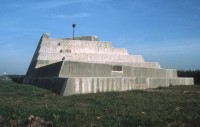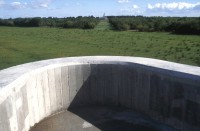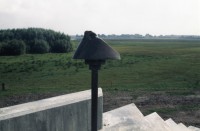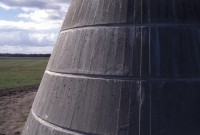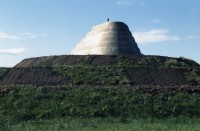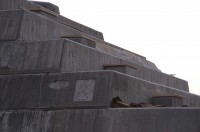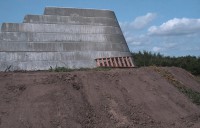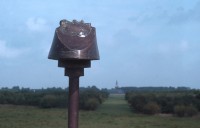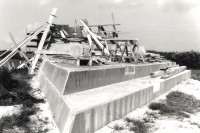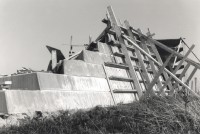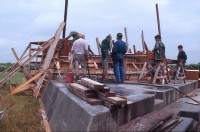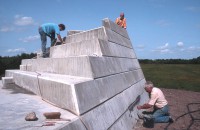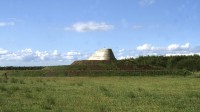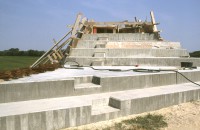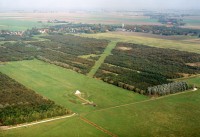Herinnering aan een plek, een beeld voor een bos – 1995
Finsterwolde, Noord Oost Groningen. In opdracht van Staatsbosbeheer regio Groningen.
Materiaal: aarde, beton, brons en uitgekapte laan
Hoogte platform inclusief aarden heuvel 6 meter boven maaiveld; lengte laan 500 meter
Herinnering aan een plek wijkt in meer dan één opzicht af van gangbare kunst in de openbare ruimte. Niet alleen kwamen het budget en de opdracht op een ongebruikelijke manier tot stand – overheidssubsidies werden aangevuld met sponsorgelden en het initiatief kwam van de kunstenaar zelf en niet van een overheidsinstantie – maar het kunstwerk is als grootschalige ingreep ook een gedeeltelijke herinrichting van het aanwezige landschap.
‘Herinnering aan een plek’ is gesitueerd op de grens van een nieuw aangelegd bos en lager gelegen nat land, waar de natuur vrij spel kreeg na afgraving van een dikke laag landbouwgrond. De verwijderde aarde is hergebruikt bij de aanleg van de terrasvormige heuvel, die als voetstuk of sokkel dient voor het eigenlijke beeld, een trapachtig, betonnen element. De omvang en de maat van de terrassen en traptreden verlopen geleidelijk van groot naar klein. Boven op het platform staat een bronzen handafdruk als rustpunt voor en begroeting van de bezoeker. Zo symboliseert het beeld de overgang van de uitgestrekte landschappelijke ruimte naar de menselijke maat. Het beeld met de handafdruk als voltooiing van de beweging van groot naar klein is tevens de plaats vanwaar de blik weer wordt gericht op het weidse omringende landschap en de toren in de verte.
Onderdeel van het beeld is de laan als zichtlijn en tevens wandelpad diagonaal door het bos richting de toren van Finsterwolde. Het zicht op de toren dat door het nieuw aangelegde bos werd belemmerd, is hierdoor weer hersteld. De laan heeft een perspectivische vertekening: smal vanaf de kant van het beeld en twee keer zo breed aan de kant richting toren, waardoor de afstand tot de toren korter lijkt dan hij in werkelijkheid is.
Het beeld kwam tot stand in het kader van de ‘herinrichting’, in opdracht van Staatsbosbeheer regio Groningen. Met medewerking van Wim Boetze van Dienst Landinrichting en Beheer Landbouwgronden Groningen.
Englisch
Ode to a Spot
Finsterwolde, North East Groningen. By order of the National Forest Service.
The total height included hill: 6 metre. Forest Avenue at tower is 500 metres long.
Earth, concrete and the ‘handchair’ is made of brass.
Ode to a Spot differs in many respects from the other sculptures in the landscape renewal. Not only did the budget and the commission come about in an unusual way – government subsidies were supplemented by private donors after Semna van Ooy herself took the initiative to generate a work of art – also a choice was made for a large-scale project integrated into the layout of the landscape. The artist’s sculpture is situated on the edge of newly planted woodlands and a lower lying area, where nature was allowed to take its course after the removal of a thick layer of agricultural soil. This available soil was reworked into the terraced hill, which forms the basis of the artwork. The hill is adorned with a stair-like concrete construction. The circumference and size of the terraces and steps taper from large to small, symbolising the general organisation of the landscape: the transition from the large natural space to the small human scale. At the top of the stairs is a bronze hand rest, a refuge for the visitor’s hand. Though the sculpture ends here, this is the departure point for the panorama.
Semna van Ooy’s hill-shaped sculpture is accompanied by a corridor – cut through the woods – in the direction of the church tower in the Dutch village of Finsterwolde. This corridor is both footpath and sightline. The tower, a landmark beacon which would be concealed from view if the woods were full-grown, is so spared in this new landscape. Moreover, because the corridor coming from the hill broadens out in the direction of the village, a distortion in perspective is created – which ostensibly pulls the tower closer and draws it into the artwork. In this sense, Ode to a Spot is also a hinge between old and new.
Text: Wim Boetze
From the 1996 publication: Staat hier ergens een beeld? (Is There a Sculpture Here?) This book was released in conjunction with sculptures being placed in the redeveloped landscape of East-Groningen and the Drenthe Peat District.
